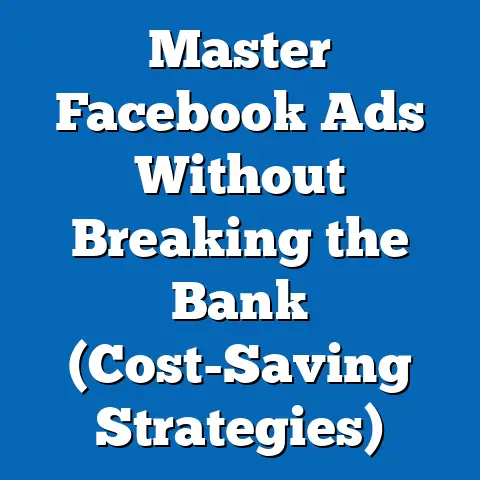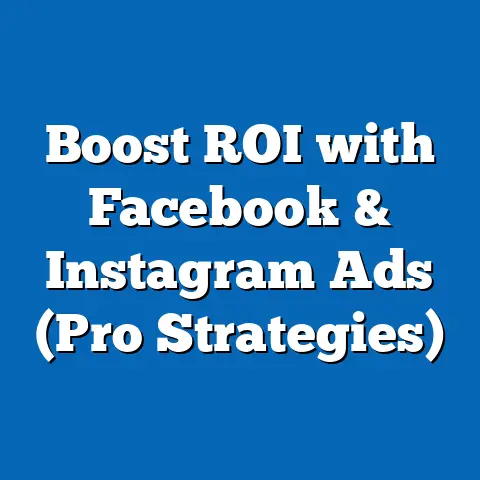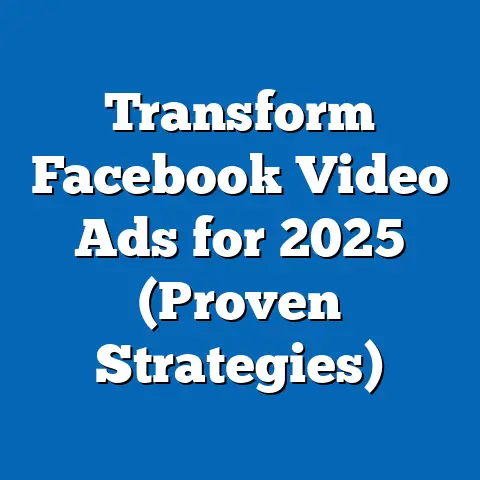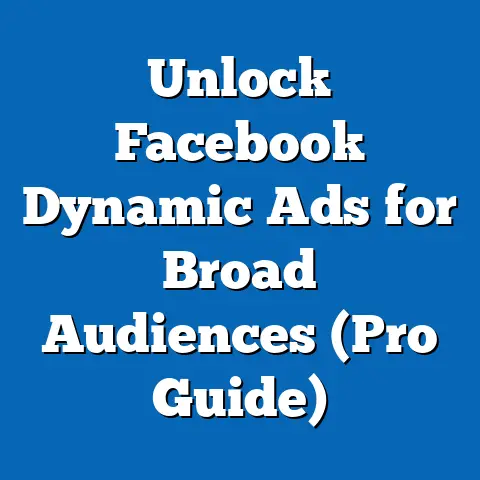Top Facebook Ads for Jewelry (Proven Strategies Inside)
Imagine a small jewelry brand, “LuxeGems,” that started in a quaint shop downtown. Despite having exquisite designs and high-quality materials, LuxeGems struggled to attract customers beyond its local community. Faced with increasing competition and limited foot traffic, the owner decided to explore Facebook advertising to reach a broader audience. Within a few months, LuxeGems not only increased its online sales but also built a loyal customer base that spanned across the country. I love hearing stories like this because it highlights the power of targeted advertising. In this article, we will delve into the top Facebook ads strategies that helped LuxeGems thrive in the competitive jewelry market and how you can implement these proven tactics for your business. I’ll share my own experiences and insights to help you craft winning campaigns.
Understanding the Jewelry Market on Facebook
The jewelry industry is thriving on Facebook, and it’s no accident. Jewelry is a highly visual product, and Facebook is a visually driven platform. This makes it a natural fit for showcasing stunning pieces and attracting potential buyers. I’ve seen firsthand how jewelry brands can leverage Facebook’s targeting capabilities to reach specific demographics and interests, leading to impressive ROI.
The Current Landscape
Currently, the jewelry market on Facebook is diverse, ranging from small, artisanal businesses to large, established brands. Here’s what I’ve observed:
- High Competition: The market is competitive, meaning you need to stand out with exceptional visuals, compelling copy, and strategic targeting.
- Visual Focus: Ads with high-quality images and videos perform significantly better. People buy jewelry with their eyes first.
- Mobile-First Approach: A large percentage of Facebook users access the platform via mobile devices, so your ads must be optimized for mobile viewing.
- Personalization: Ads that are tailored to individual interests and preferences tend to have higher engagement rates.
- E-commerce Integration: Many jewelry brands are directly selling through Facebook Shops, making the buying process seamless.
Demographics of Jewelry Buyers
Understanding the demographics of jewelry buyers on Facebook is crucial for effective targeting. Based on my research and experience, here are some key demographics to consider:
- Age: The most active jewelry buyers on Facebook are typically between 25 and 54 years old. However, this can vary depending on the type of jewelry you’re selling. For instance, younger audiences might be interested in trendy, affordable pieces, while older audiences may prefer classic, high-end items.
- Gender: While jewelry is often marketed towards women, men are also significant buyers, especially for gifts or men’s jewelry.
- Location: Urban areas tend to have a higher concentration of jewelry buyers, but online advertising allows you to reach customers anywhere.
- Interests: Common interests among jewelry buyers include fashion, luxury goods, weddings, anniversaries, and specific jewelry types (e.g., diamonds, gemstones, pearls).
- Income: Higher-income individuals are more likely to purchase expensive jewelry, but there is also a market for affordable and mid-range options.
The Importance of Targeting
Targeting is the cornerstone of successful Facebook advertising. Without precise targeting, your ads may reach the wrong audience, resulting in wasted ad spend and low conversion rates. Here’s why it’s so important:
- Relevance: Targeted ads are more relevant to the users who see them, increasing the likelihood of engagement and conversion.
- Efficiency: By focusing on potential customers, you can maximize your ad budget and achieve a higher ROI.
- Personalization: Targeted ads allow you to personalize your messaging and visuals to resonate with specific audience segments.
- Reduced Ad Fatigue: Showing your ads to the right people reduces the risk of ad fatigue, where users become desensitized to your ads.
Takeaway: To succeed in the jewelry market on Facebook, you must understand the current landscape, identify your target audience, and leverage precise targeting to reach potential buyers effectively.
Defining Your Target Audience
Creating well-defined customer personas is essential for targeting your Facebook ads effectively. Customer personas are semi-fictional representations of your ideal customers, based on research and data about your existing and potential customers.
Creating Customer Personas
Here’s how to create customer personas specific to jewelry buyers:
- Gather Data: Start by collecting data about your existing customers. Use surveys, interviews, and analytics tools to gather information about their demographics, interests, behaviors, and pain points.
- Identify Common Traits: Look for common traits and patterns in your data. Group customers with similar characteristics into distinct segments.
- Create Persona Profiles: Develop detailed profiles for each customer segment. Give each persona a name, age, occupation, and a backstory. Describe their motivations, goals, and challenges.
-
Example Personas:
-
The Romantic Gifter:
- Name: Mark, 32
- Occupation: Software Engineer
-
Backstory: Mark wants to surprise his girlfriend with a special gift for their anniversary. He is looking for a unique and meaningful piece of jewelry that shows his love and appreciation.
- The Fashion-Forward Trendsetter:
-
Name: Emily, 25
- Occupation: Marketing Assistant
-
Backstory: Emily loves to stay on top of the latest fashion trends. She is looking for trendy and affordable jewelry that complements her style and makes her stand out.
- The Luxury Connoisseur:
-
Name: James, 45
- Occupation: Executive
- Backstory: James appreciates high-quality craftsmanship and timeless design. He is looking for luxury jewelry that reflects his status and sophistication.
- Refine and Update: Regularly review and update your customer personas as you gather more data and insights.
-
Example Personas:
-
The Romantic Gifter:
- Name: Mark, 32
- Occupation: Software Engineer
-
Backstory: Mark wants to surprise his girlfriend with a special gift for their anniversary. He is looking for a unique and meaningful piece of jewelry that shows his love and appreciation.
- The Fashion-Forward Trendsetter:
-
Name: Emily, 25
- Occupation: Marketing Assistant
-
Backstory: Emily loves to stay on top of the latest fashion trends. She is looking for trendy and affordable jewelry that complements her style and makes her stand out.
- The Luxury Connoisseur:
-
Name: James, 45
- Occupation: Executive
- Backstory: James appreciates high-quality craftsmanship and timeless design. He is looking for luxury jewelry that reflects his status and sophistication.
- Refine and Update: Regularly review and update your customer personas as you gather more data and insights.
The Romantic Gifter:
- Name: Mark, 32
- Occupation: Software Engineer
-
Backstory: Mark wants to surprise his girlfriend with a special gift for their anniversary. He is looking for a unique and meaningful piece of jewelry that shows his love and appreciation.
- The Fashion-Forward Trendsetter:
-
Name: Emily, 25
- Occupation: Marketing Assistant
-
Backstory: Emily loves to stay on top of the latest fashion trends. She is looking for trendy and affordable jewelry that complements her style and makes her stand out.
- The Luxury Connoisseur:
-
Name: James, 45
- Occupation: Executive
- Backstory: James appreciates high-quality craftsmanship and timeless design. He is looking for luxury jewelry that reflects his status and sophistication.
- Refine and Update: Regularly review and update your customer personas as you gather more data and insights.
Backstory: Mark wants to surprise his girlfriend with a special gift for their anniversary. He is looking for a unique and meaningful piece of jewelry that shows his love and appreciation.
- The Fashion-Forward Trendsetter:
Name: Emily, 25
Backstory: Emily loves to stay on top of the latest fashion trends. She is looking for trendy and affordable jewelry that complements her style and makes her stand out.
- The Luxury Connoisseur:
Name: James, 45
Using Facebook’s Audience Insights Tool
Facebook’s Audience Insights tool is a powerful resource for identifying potential customers. Here’s how to use it:
- Access the Tool: Go to Facebook Ads Manager and click on “Audience Insights” in the “Tools” menu.
- Select Your Audience: Choose whether to analyze everyone on Facebook or people connected to your page.
- Explore Demographics: Use the tool to explore the demographics of your target audience, including age, gender, education, and relationship status.
- Discover Interests: Identify the interests and hobbies that are popular among your target audience. This can help you refine your targeting and create more relevant ads.
- Analyze Behaviors: Analyze the behaviors of your target audience, such as their purchase habits, device usage, and page likes.
- Save Your Audience: Save your audience insights for future use in your Facebook ad campaigns.
Effective Audience Segmentation
Effective audience segmentation is crucial for tailoring your ads to specific groups of jewelry buyers. Here are some examples of audience segmentation for different jewelry styles:
-
Engagement Rings:
- Targeting: Engaged or newly engaged individuals, people interested in weddings, anniversaries, and romantic gifts.
- Messaging: Focus on the symbolism of engagement rings and the importance of finding the perfect ring to represent their love.
-
Handmade Pieces:
-
Targeting: People interested in artisanal crafts, unique designs, and supporting small businesses.
- Messaging: Highlight the craftsmanship and uniqueness of handmade jewelry. Emphasize the story behind the pieces and the passion of the artisan.
-
Luxury Jewelry:
-
Targeting: High-income individuals, people interested in luxury brands, and those who appreciate fine craftsmanship.
- Messaging: Focus on the exclusivity and prestige of luxury jewelry. Highlight the high-quality materials and timeless design.
-
Affordable Fashion Jewelry:
-
Targeting: Younger audiences, fashion enthusiasts, and people looking for trendy accessories.
- Messaging: Focus on the affordability and versatility of fashion jewelry. Highlight the latest trends and how the pieces can be styled with different outfits.
Engagement Rings:
- Targeting: Engaged or newly engaged individuals, people interested in weddings, anniversaries, and romantic gifts.
- Messaging: Focus on the symbolism of engagement rings and the importance of finding the perfect ring to represent their love.
-
Handmade Pieces:
-
Targeting: People interested in artisanal crafts, unique designs, and supporting small businesses.
- Messaging: Highlight the craftsmanship and uniqueness of handmade jewelry. Emphasize the story behind the pieces and the passion of the artisan.
-
Luxury Jewelry:
-
Targeting: High-income individuals, people interested in luxury brands, and those who appreciate fine craftsmanship.
- Messaging: Focus on the exclusivity and prestige of luxury jewelry. Highlight the high-quality materials and timeless design.
-
Affordable Fashion Jewelry:
-
Targeting: Younger audiences, fashion enthusiasts, and people looking for trendy accessories.
- Messaging: Focus on the affordability and versatility of fashion jewelry. Highlight the latest trends and how the pieces can be styled with different outfits.
Handmade Pieces:
Targeting: People interested in artisanal crafts, unique designs, and supporting small businesses.
Luxury Jewelry:
Targeting: High-income individuals, people interested in luxury brands, and those who appreciate fine craftsmanship.
Affordable Fashion Jewelry:
Targeting: Younger audiences, fashion enthusiasts, and people looking for trendy accessories.
Takeaway: By creating detailed customer personas, leveraging Facebook’s Audience Insights tool, and implementing effective audience segmentation, you can target your Facebook ads to reach the right jewelry buyers and maximize your ROI.
Crafting Compelling Ad Copy
The copy in your Facebook ads is just as important as the visuals. Compelling ad copy can capture the attention of potential customers, evoke emotion, and prompt them to take action.
Key Elements of Persuasive Ad Copy
Here are the key elements of persuasive ad copy that resonates with jewelry shoppers:
- Headline: The headline is the first thing people see, so it needs to be attention-grabbing and relevant. Use strong keywords and highlight the unique value proposition of your jewelry.
- Body Text: The body text should provide more details about your jewelry and explain why it’s worth buying. Focus on the benefits, not just the features.
- Emotion: Evoke emotion by telling a story or highlighting the sentimental value of jewelry.
- Social Proof: Include social proof, such as customer testimonials or reviews, to build trust and credibility.
- Call-to-Action (CTA): Use a clear and concise CTA to tell people what you want them to do, such as “Shop Now,” “Learn More,” or “Get Yours Today.”
Successful Ad Headlines and Body Text
Here are some examples of successful ad headlines and body text that evoke emotion and prompt action:
-
Headline: “Celebrate Your Love with a Timeless Diamond Ring”
- Body Text: “Discover our exquisite collection of diamond engagement rings, crafted with the finest materials and designed to last a lifetime. Show your love with a symbol of everlasting commitment.”
-
Headline: “Add a Touch of Elegance to Your Style”
-
Body Text: “Explore our stunning range of handcrafted jewelry, perfect for any occasion. From delicate necklaces to statement earrings, find the perfect piece to express your unique style.”
-
Headline: “Limited Time Offer: 20% Off All Jewelry”
-
Body Text: “Don’t miss out on our exclusive sale! Get 20% off all jewelry for a limited time only. Shop now and treat yourself or a loved one to a beautiful piece.”
Headline: “Celebrate Your Love with a Timeless Diamond Ring”
- Body Text: “Discover our exquisite collection of diamond engagement rings, crafted with the finest materials and designed to last a lifetime. Show your love with a symbol of everlasting commitment.”
-
Headline: “Add a Touch of Elegance to Your Style”
-
Body Text: “Explore our stunning range of handcrafted jewelry, perfect for any occasion. From delicate necklaces to statement earrings, find the perfect piece to express your unique style.”
-
Headline: “Limited Time Offer: 20% Off All Jewelry”
-
Body Text: “Don’t miss out on our exclusive sale! Get 20% off all jewelry for a limited time only. Shop now and treat yourself or a loved one to a beautiful piece.”
Headline: “Add a Touch of Elegance to Your Style”
Body Text: “Explore our stunning range of handcrafted jewelry, perfect for any occasion. From delicate necklaces to statement earrings, find the perfect piece to express your unique style.”
Headline: “Limited Time Offer: 20% Off All Jewelry”
Body Text: “Don’t miss out on our exclusive sale! Get 20% off all jewelry for a limited time only. Shop now and treat yourself or a loved one to a beautiful piece.”
The Importance of a Strong CTA
A strong call-to-action (CTA) is crucial for driving conversions. Here’s why:
- Clarity: A clear CTA tells people exactly what you want them to do.
- Urgency: CTAs that create a sense of urgency, such as “Shop Now” or “Limited Time Offer,” can encourage people to take action immediately.
- Relevance: CTAs should be relevant to the context of the ad and the target audience.
- Placement: Place your CTA prominently in your ad, so it’s easy to see and click.
Takeaway: Crafting compelling ad copy involves writing attention-grabbing headlines, persuasive body text, and including a strong call-to-action. By focusing on the benefits of your jewelry and evoking emotion, you can create ads that resonate with your target audience and drive conversions.
Stunning Visuals That Capture Attention
In the jewelry industry, visuals are everything. High-quality images and videos can capture the attention of potential customers, showcase the beauty of your jewelry, and drive conversions.
The Role of High-Quality Images and Videos
Here’s why high-quality images and videos are essential for jewelry advertising:
- First Impression: Visuals are the first thing people see, so they need to be visually appealing and professional.
- Showcase Details: High-quality visuals allow you to showcase the intricate details and craftsmanship of your jewelry.
- Build Trust: Professional visuals can build trust and credibility with potential customers.
- Drive Engagement: Compelling visuals can capture the attention of people scrolling through their Facebook feeds and encourage them to engage with your ads.
Tips for Photographing Jewelry
Here are some tips for photographing jewelry to highlight its features:
- Lighting: Use soft, natural lighting to highlight the sparkle and shine of your jewelry. Avoid harsh shadows and reflections.
- Angles: Experiment with different angles to showcase the unique features of your jewelry.
- Background: Use a clean, neutral background to avoid distractions.
- Focus: Ensure that your jewelry is in sharp focus.
- Props: Use props sparingly to add context and visual interest.
The Effectiveness of Video Ads
Video ads are particularly effective for showcasing the craftsmanship and design process of jewelry. Here’s why:
- Engagement: Video ads are more engaging than static images and can capture the attention of people scrolling through their Facebook feeds.
- Storytelling: Video ads allow you to tell a story about your jewelry and connect with your audience on an emotional level.
- Showcase Details: Video ads allow you to showcase the intricate details and craftsmanship of your jewelry in a dynamic way.
- Demonstration: Video ads can demonstrate how your jewelry looks when worn and how it can be styled with different outfits.
Takeaway: Stunning visuals are essential for capturing the attention of potential customers and showcasing the beauty of your jewelry. By using high-quality images and videos, you can create ads that are visually appealing, engaging, and persuasive.
Utilizing Facebook’s Ad Formats for Jewelry
Facebook offers a variety of ad formats that can be used to showcase jewelry effectively. Each format has its unique strengths and can be used to achieve different advertising goals.
Carousel Ads
Carousel ads allow you to showcase multiple images or videos in a single ad. Here’s how to use carousel ads for jewelry:
- Showcase a Variety of Products: Use carousel ads to showcase a variety of different jewelry styles or collections.
- Highlight Key Features: Use each card in the carousel to highlight a key feature or benefit of your jewelry.
- Tell a Story: Use the carousel to tell a story about your brand or your jewelry.
- Link to Specific Products: Link each card in the carousel to a specific product page on your website.
Collection Ads
Collection ads are designed to showcase products in a visually appealing and immersive way. Here’s how to use collection ads for jewelry:
- Showcase a Collection: Use collection ads to showcase a curated collection of jewelry.
- Create a Visual Catalog: Use collection ads to create a visual catalog of your jewelry.
- Link to a Product Page: Link the collection ad to a product page on your website, where people can browse and purchase your jewelry.
Dynamic Ads
Dynamic ads allow you to automatically show relevant products to people who have visited your website or expressed interest in your jewelry. Here’s how to use dynamic ads for jewelry:
- Retargeting: Use dynamic ads to retarget people who have visited your website and show them the jewelry they viewed.
- Cross-Selling: Use dynamic ads to cross-sell related products to people who have purchased jewelry from you.
- Personalization: Use dynamic ads to personalize the ads based on the individual’s browsing history and preferences.
Case Studies
-
Example 1: Alex and Ani
- Alex and Ani used carousel ads to showcase their collection of charm bracelets. Each card in the carousel highlighted a different charm and its meaning. The ads linked to specific product pages, making it easy for people to purchase the bracelets.
-
Example 2: Tiffany & Co.
-
Tiffany & Co. used collection ads to showcase their iconic jewelry collections. The ads featured stunning visuals and linked to a product page where people could browse and purchase the jewelry.
-
Example 3: Mejuri
-
Mejuri used dynamic ads to retarget people who had visited their website. The ads showed the jewelry that people had viewed, reminding them to make a purchase.
Example 1: Alex and Ani
- Alex and Ani used carousel ads to showcase their collection of charm bracelets. Each card in the carousel highlighted a different charm and its meaning. The ads linked to specific product pages, making it easy for people to purchase the bracelets.
-
Example 2: Tiffany & Co.
-
Tiffany & Co. used collection ads to showcase their iconic jewelry collections. The ads featured stunning visuals and linked to a product page where people could browse and purchase the jewelry.
-
Example 3: Mejuri
-
Mejuri used dynamic ads to retarget people who had visited their website. The ads showed the jewelry that people had viewed, reminding them to make a purchase.
Example 2: Tiffany & Co.
Tiffany & Co. used collection ads to showcase their iconic jewelry collections. The ads featured stunning visuals and linked to a product page where people could browse and purchase the jewelry.
Example 3: Mejuri
Mejuri used dynamic ads to retarget people who had visited their website. The ads showed the jewelry that people had viewed, reminding them to make a purchase.
Takeaway: By utilizing Facebook’s various ad formats, you can create visually appealing and engaging ads that showcase your jewelry effectively. Carousel ads, collection ads, and dynamic ads each have unique strengths and can be used to achieve different advertising goals.
Retargeting Strategies to Boost Sales
Retargeting is a powerful strategy for boosting sales in the jewelry niche. It involves showing ads to people who have previously interacted with your brand, such as visiting your website, viewing your products, or engaging with your ads.
The Concept of Retargeting
Retargeting works by placing a pixel on your website, which tracks the behavior of visitors. When someone visits your website, the pixel adds them to a retargeting audience. You can then show ads specifically to this audience, reminding them of your brand and encouraging them to make a purchase.
Setting Up Retargeting Campaigns
Here’s how to set up retargeting campaigns for customers who have visited your website or engaged with your ads:
- Install the Facebook Pixel: Install the Facebook pixel on your website to track visitor behavior.
- Create Custom Audiences: Create custom audiences based on specific actions that people have taken on your website, such as visiting specific pages, adding items to their cart, or making a purchase.
- Create Retargeting Ads: Create retargeting ads that are tailored to the interests and behavior of your retargeting audience.
- Set Your Budget: Set a budget for your retargeting campaigns.
- Launch Your Campaigns: Launch your retargeting campaigns and monitor their performance.
Proven Strategies for Crafting Retargeting Ads
Here are some proven strategies for crafting retargeting ads that convert window shoppers into buyers:
- Remind Them of What They Viewed: Show people the jewelry they viewed on your website.
- Offer a Discount: Offer a discount or promotion to encourage people to make a purchase.
- Highlight the Benefits: Highlight the benefits of your jewelry, such as its high quality or unique design.
- Use Social Proof: Include social proof, such as customer testimonials or reviews, to build trust and credibility.
- Create Urgency: Create a sense of urgency by highlighting limited-time offers or low stock levels.
Takeaway: Retargeting is a powerful strategy for boosting sales in the jewelry niche. By setting up retargeting campaigns and crafting ads that are tailored to the interests and behavior of your retargeting audience, you can convert window shoppers into buyers.
Leveraging User-Generated Content (UGC)
User-generated content (UGC) is content created by your customers, such as photos, videos, and testimonials. Incorporating UGC in your Facebook ads can be a powerful way to build trust, credibility, and social proof.
Benefits of Incorporating UGC
Here are the benefits of incorporating UGC in Facebook ads for jewelry brands:
- Authenticity: UGC is seen as more authentic and trustworthy than branded content.
- Social Proof: UGC provides social proof that your jewelry is worth buying.
- Engagement: UGC can increase engagement with your ads, as people are more likely to interact with content created by their peers.
- Cost-Effective: UGC is often more cost-effective than creating your own content.
Ways to Encourage Customers to Share UGC
Here are some ways to encourage customers to share photos and testimonials:
- Run a Contest: Run a contest or giveaway and ask customers to share photos of themselves wearing your jewelry.
- Ask for Reviews: Ask customers to leave reviews on your Facebook page or website.
- Feature Customers: Feature customers on your Facebook page and in your ads.
- Use a Hashtag: Create a hashtag for your brand and encourage customers to use it when sharing photos of your jewelry.
Successful UGC Campaigns
Here are some examples of successful UGC campaigns in the jewelry industry:
- Pandora: Pandora encourages customers to share photos of their charm bracelets on social media using the hashtag #PandoraStyle.
- Daniel Wellington: Daniel Wellington features customer photos on their Instagram page and in their ads.
- Etsy: Etsy showcases customer reviews and testimonials on their product pages.
Takeaway: Incorporating user-generated content in your Facebook ads can be a powerful way to build trust, credibility, and social proof. By encouraging customers to share photos and testimonials, you can create ads that are authentic, engaging, and cost-effective.
Measuring Success and Adjusting Your Strategy
Measuring the success of your Facebook ad campaigns is crucial for optimizing your strategy and maximizing your ROI.
Key Metrics to Track
Here are the key metrics to track for Facebook ad campaigns in the jewelry niche:
- Click-Through Rate (CTR): The percentage of people who click on your ad after seeing it.
- Conversion Rate: The percentage of people who take a desired action, such as making a purchase, after clicking on your ad.
- Cost Per Click (CPC): The average cost you pay for each click on your ad.
- Cost Per Conversion (CPC): The average cost you pay for each conversion.
- Return on Ad Spend (ROAS): The amount of revenue you generate for every dollar you spend on advertising.
The Importance of A/B Testing
A/B testing is a process of comparing two versions of an ad to see which one performs better. A/B testing can help you optimize your ad copy, visuals, targeting, and other elements to improve your ad performance.
Analyzing Data
Here are some insights on analyzing data to make informed decisions for future campaigns:
- Identify What Works: Analyze your data to identify what elements of your ads are performing well and what elements are not.
- Optimize Your Ads: Optimize your ads based on your data. For example, if you find that a particular headline is performing well, use it in other ads.
- Refine Your Targeting: Refine your targeting based on your data. For example, if you find that a particular demographic is converting well, focus your ads on that demographic.
- Test New Ideas: Test new ideas and strategies to see if they improve your ad performance.
Takeaway: Measuring the success of your Facebook ad campaigns, A/B testing your ads, and analyzing your data are essential for optimizing your strategy and maximizing your ROI.
Conclusion
In conclusion, Facebook advertising offers immense potential for jewelry brands to reach and convert a larger audience. By understanding the jewelry market on Facebook, defining your target audience, crafting compelling ad copy, using stunning visuals, utilizing Facebook’s ad formats, implementing retargeting strategies, leveraging user-generated content, and measuring your success, you can create Facebook ad campaigns that drive sales and build brand awareness.
With the right targeting, compelling visuals, and engaging content, jewelry brands can effectively leverage Facebook ads to reach and convert a larger audience. I encourage you to implement these proven strategies to elevate your jewelry advertising game and maximize your online presence. Remember to stay adaptable, continuously test new approaches, and always keep your target audience in mind. Your next successful Facebook ad campaign for jewelry is just around the corner!





